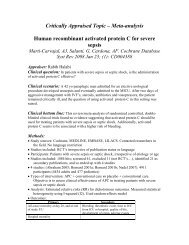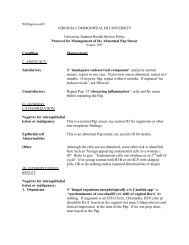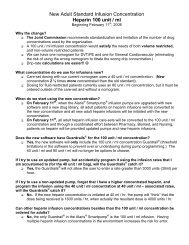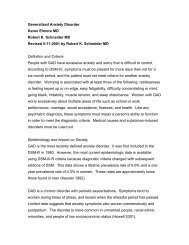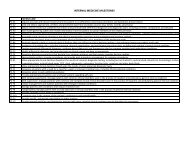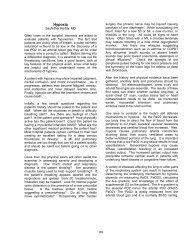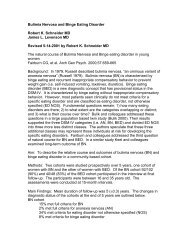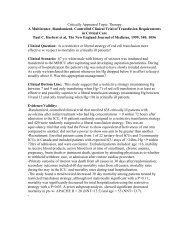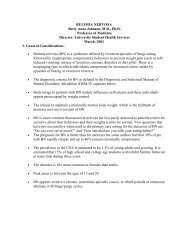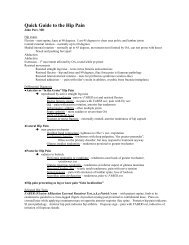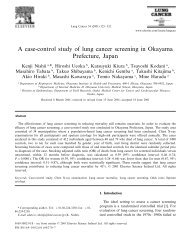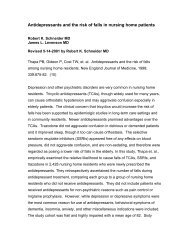Intern Survival Guide 2011-2012 - VCU Internal Medicine Electronic ...
Intern Survival Guide 2011-2012 - VCU Internal Medicine Electronic ...
Intern Survival Guide 2011-2012 - VCU Internal Medicine Electronic ...
Create successful ePaper yourself
Turn your PDF publications into a flip-book with our unique Google optimized e-Paper software.
4. AMS: Always evaluate promptly and do a quick exam to determine if the situationis acute (unresponsive, blown pupil, acute change in orientation). Checkthe airway-if pt can’t maintain their airway, then call the MRICU. If they canmaintain their airway, call your resident and check an ABG (for inc CO2) andfingerstick blood glucose. Talk to resident about stat labs: BMP, cultures,CBC, LFTs (ammonia). Decide quickly whether or not the patient needs anoncontrast head CT.5. Confused Old People (Elderly delirium) – 20% of elderly become delirious inhospital, ~80% if preexisting dementia or ICU stay.Delirium: acute, fluctuating AMS, inattention, difficulty concentration,and disorganized thought.(rambling/incoherent language).Causes: MEDS (opioids, sedatives, ANTICHOLINERGICS, ETOH/drug withdrawal, polypharmacy), Brain (CVA, bleed, meningitis),Illness (Infxn ie: UTI, hypoxia, shock, dehydration, fever, HYPO-GLYCEMIA). Post-Op.Work-up: VS including pulse-ox, CHECK GLUCOSE, review meds,neuro/eye exam for focal findings (if present get Head CT).Management: Redirection, then meds, then physical restraints (uselast, try to avoid). Haldol 0.5-1.0mg IV, atypical antipsychotics—allprolong QT except aripiprazole.6. Chest Pain: Always evaluate promptly. If the pt looks unstable, call yourresident. ALWAYS get an EKG. If you are even slightly concerned for anMI, send cardiac enzymes. If the EKG or history is suggestive of ischemia,give the pt aspirin 325mg, SL nitroglycerin (up to 3 doses in 15 minutes—canlower BP so call your resident before giving if BP is low), and oxygen. Yourgoal is to get the pt chest pain free. If the pt is not pain free after 3 doses ofSLNG, or has suspicious ECG findings, then the CCU resident should be notified.Your resident should be involved ASAP—definitely before calling CCU,and before giving heparin/lovenox. Remember: time is muscle for cardiac ischemia/infarct.7. SOB/Hypoxia: Again, evaluate promptly, especially if vitals (which nurseshould have given you on the phone) sound unstable (tachypnea>25/minute,tachycardia>100, hypotensive, sats
to get an ECG while you’re on the way. When you arrive, check for pulse-ifthey don’t have one, call a code blue. If pt looks unstable, call your resident.Management of tachycardia depends on whether the pt is hypotensive and/orsymptomatic—if they are, you should call your resident to bedside, get thecode cart ready and follow your ACLS algorithm for unstable tachycardia.For a stable tachycardia (no symptoms, BP normal), you have some options.For known A fib with RVR, you can use diltiazem or metoprolol IV,but be aware that these can lower BP. If you’re pushing meds IV,your resident should be involved.For a regular wide complex tachycardia with a pulse, call your residentfor assistance immediately. (If no pulse, call a code.)For a regular narrow complex tachycardia that you can’t identify, callyour resident to bedside to see if adenosine is warranted.Sinus tachycardia IS NEVER treated with AVN blockade, figure outwhat’s causing it and fix problem.8. Hypotension: Causes are numerous and include hemorrhage, CHF, sepsis,arrhythmia/tachycardia, PE, MI, tamponade, cirrhosis, and meds. If pt issymptomatic or has had a significant drop in their BP, evaluate at beside immediately.If the pt appears unstable, call your resident to come evaluatethe pt. Starting a fluid bolus is usually safe, as long as pt isn’t volume overloadedand is not anuric. Remember-only IVF boluses help blood pressure; arate of 125cc/hr won’t help acutely. If the pt appears stable, take the time to gothrough the chart—look at recent meds, trends in vitals, and build a differentialdx to discuss with your resident. If pt looks septic, consider adding/broadeningantibiotics. If a pt is still hypotensive after 6 L IVF boluses, then they needpressors, and the MRICU resident should be notified.9. Hypertension: Efforts should be made to acutely correct a pt’s BP if they aresymptomatic or their BP is >170/100. If they are symptomatic (CP, SOB,AMS, no UOP), they have hypertensive emergency (end organ damage) andyou should call your resident. If not, pt has hypertensive urgency and you cantake your time (up to 12-24 hours) to lower BP. You can even check to seewhen pt’s next antihypertensive medicine is due to be given. If it’s within thenext few hours, just ask the nurse to give it early. Rapid onset meds that canbe used acutely include nitropaste (venous dilator, not great), IV labetalol, PO/IV hydralazine, PO clonidine, PO captopril.10. Low Urine Output – normal > 0.5ml/kg/hr (usually > 30mls). Oliguria 50mL post-void residual abnl, >200mL post-void = need for Foley). Alsoconsider hypovolemia, decreased cardiac output (MI, CHF), sepsis, contrastinduced nephropathy. If not volume overloaded, usually safe to try a 500mLsaline bolus. LASIX DOES NOT ―TREAT‖ LOW URINE OUTPUT!9



